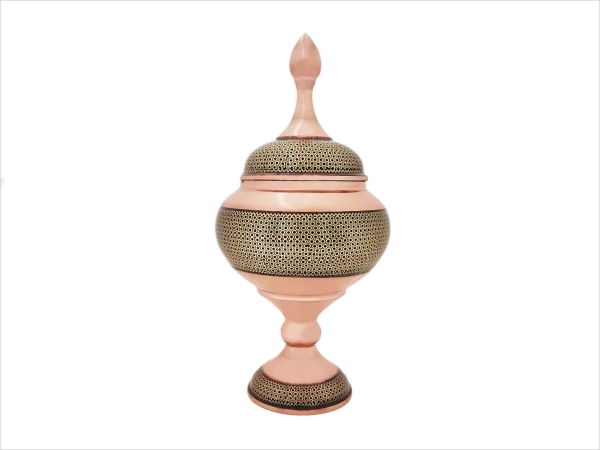Large copper and inlay chocolate container ME-1002
Copper and inlaid chocolate ME-1002 is an extremely beautiful and valuable product. The material of this chocolate inlay is copper and the inlay material on it is wood, camel bone and brass metal. The height of eating chocolate is 27 cm and its weight is about 650 grams. Beautiful and eye-catching art to beautify your home.
inlay
One of the most valuable and significant Iranian handicrafts is the art of inlay work. This art is the jewel of our country’s handicrafts ring. Becomes. These triangles are made of wood, metal and bone. The first inlaid works found in Iran 1000 years ago are in the city of Shiraz. Also, this art has been popular since the Safavid era and has reached its peak of prosperity after that. Inlay is obtained from a combination of polygons and geometric shapes whose sides are equal. These shapes are five, six, seven, octagonal or ten-sided. The delicacy of this work is very high and of course it requires a lot of patience.
Applications of inlay work
Examples of inlays used in the past: Inlaid pulpit and roof of the porch of Atiq Mosque in Shiraz, inlaid doors of Timur Palace in Samarkand, flower and bush doors of Bukhara, Golestan Palace hall doors, wooden pulpit of Lebanon Lebanese Mosque, door The inlays are located in the King Abdolazim Hassani Museum, the inlaid room of the Marble Palace and the Khatam Hall of the National Assembly. The following can also be expressed from the old works of inlay art:
- Shrine of Imam Musa Kazem (AS) and Imam Mohammad Taqi (AS) in Kazemin related to the reign of Shah Ismail Safavid
- Imam Hassan Askari (AS) Shrine Fund and also Imam Ali Naqi (AS) Shrine Fund in Samarra during the Safavid period
- The inlay box of the shrine of Narges Khatoon, the mother of Hazrat Mahdi (as), which was built in the same Safavid period.
- The entrance door of Chaharbagh school in Isfahan
- Door Khatam Imamzadeh Shahreza in Ghomsheh (Shahreza)
- Khatam box of the shrine of Hazrat Ali (AS) made during the reign of Karim Khan Zand and installed during the reign of Lotfali Khan Zand
- Khatam box of the shrine of Imam Hussein (AS) and Hazrat Abolfazl (AS) in Karbala
- Tomb of Hazrat Zainab (AS) in the sham
At present, due to its reasonable price and eye-catching beauty, Khatam is used as a tool in most homes, such as: chessboards, jewelry boxes, chocolate eating utensils, etc., and it is also used as an office set and for business advertisements. .
Materials required for inlay work
To do this art, you need the following tools:
- Wood cutting machine
- Wood of trees such as ebony, betel, walnut, baqam, jujube, orange, kahkam-bruised
- Elephant bone and ivory – camel bone – horse bone
- Metal wires: brass-aluminum and some silver
- Oysters – flake yarn – silk – lacquer
High quality inlay feature
- High quality inlay feature
- The surface of the inlay should be smooth and full
- The color and materials used in the inlay should be uniform
- No change in color and shape
- Restorations and putties are not specified at the work level.
- Symmetry of all balls and shapes on the work surface and angles and sides
- Painting and coating without defects
- The finesse of maps and triangles
Golden Mart business group is a supplier of various Iranian and foreign products and is always at the service of our dear customers.






Reviews
There are no reviews yet.